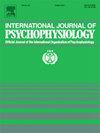生理指标对心理负荷变化的敏感性。
IF 2.6
3区 心理学
Q3 NEUROSCIENCES
引用次数: 0
摘要
精神负荷(MWL)量化了任何任务所施加的主观经历的精神压力,并为机器或系统优化提供了有趣的途径。因此,MWL的生理测量一直备受关注,但尽管经过数十年的研究,对MWL变化的敏感性仍然没有定论(Ayres等人,2021;Charles & Nixon, 2019; Tao等人,2019)。因此,本研究重新评估了六种生理指标对MWL变化的敏感性,即它们区分MWL水平的能力。随着MWL的增加,心率(HR)、眨眼频率(BR)、瞳孔扩张(PD)、皮肤电导反应(SCR)和皮肤电导水平(SCL)预计会增加,而心率变异性(HRV)预计会降低。对于MWL诱导,采用了对互换任务(Stankov & Crawford, 1993)的改编,目的是诱导四个不同的需求水平。在74名大学生的样本中,MWL操作是成功的,反应时间随着水平的提高而显著增加,而准确性则下降。NASA-Task Load Index (Hart & Staveland, 1988)对MWL的主观评分反映了这种模式。BR和PD高度敏感,随水平的增加而增加,HR和HRV敏感但不能区分细粒度的变化,HRV的无能更为明显。除了非常高的水平外,SCR是足够敏感的,而SCL则没有敏感性。这些发现为MWL生理反应的研究和应用提供了进一步的基础,更全面地反映任务需求,以及机器-操作员关系中的精神紧张。本文章由计算机程序翻译,如有差异,请以英文原文为准。
The sensitivity of psychophysiological measures to changes in mental workload
Mental Workload (MWL) quantifies the subjectively experienced mental strain imposed by any task and poses interesting avenues in machine or system optimization. Thus, the psychophysiological measurement of MWL has been of large interest, but despite multiple decades of research, sensitivity to changes in MWL remains inconclusive (Ayres et al., 2021; Charles & Nixon, 2019; Tao et al., 2019). This study therefore re-evaluates sensitivity of six psychophysiological measures to changes in MWL, namely in their ability to distinguish levels of MWL. With increasing MWL, heart rate (HR), blink rate (BR), pupil dilation (PD), skin conductance responses (SCR), and skin conductance level (SCL) were expected to increase, whereas heart rate variability (HRV) was expected to decrease. For MWL induction, an adaptation of the Swaps task (Stankov & Crawford, 1993) was employed, with the aim of inducing four distinct levels of demand. MWL manipulation was successful, as in the sample of 74 university students response times significantly increased with each level, while accuracy decreased. Subjective ratings of MWL in the NASA-Task Load Index (Hart & Staveland, 1988) reflected this pattern. BR and PD were highly sensitive, increasing with each level, while HR and HRV were sensitive but less able to differentiate fine-grained changes, with the inability being more pronounced for HRV. SCR were sufficiently sensitive, except for very high levels, and SCL showed no sensitivity. These findings provide further basis for research and application of psychophysiological responses to MWL, to represent task demands more comprehensively as well as mental strain in machine-operator relations.
求助全文
通过发布文献求助,成功后即可免费获取论文全文。
去求助
来源期刊
CiteScore
5.40
自引率
10.00%
发文量
177
审稿时长
3-8 weeks
期刊介绍:
The International Journal of Psychophysiology is the official journal of the International Organization of Psychophysiology, and provides a respected forum for the publication of high quality original contributions on all aspects of psychophysiology. The journal is interdisciplinary and aims to integrate the neurosciences and behavioral sciences. Empirical, theoretical, and review articles are encouraged in the following areas:
• Cerebral psychophysiology: including functional brain mapping and neuroimaging with Event-Related Potentials (ERPs), Positron Emission Tomography (PET), Functional Magnetic Resonance Imaging (fMRI) and Electroencephalographic studies.
• Autonomic functions: including bilateral electrodermal activity, pupillometry and blood volume changes.
• Cardiovascular Psychophysiology:including studies of blood pressure, cardiac functioning and respiration.
• Somatic psychophysiology: including muscle activity, eye movements and eye blinks.

 求助内容:
求助内容: 应助结果提醒方式:
应助结果提醒方式:


